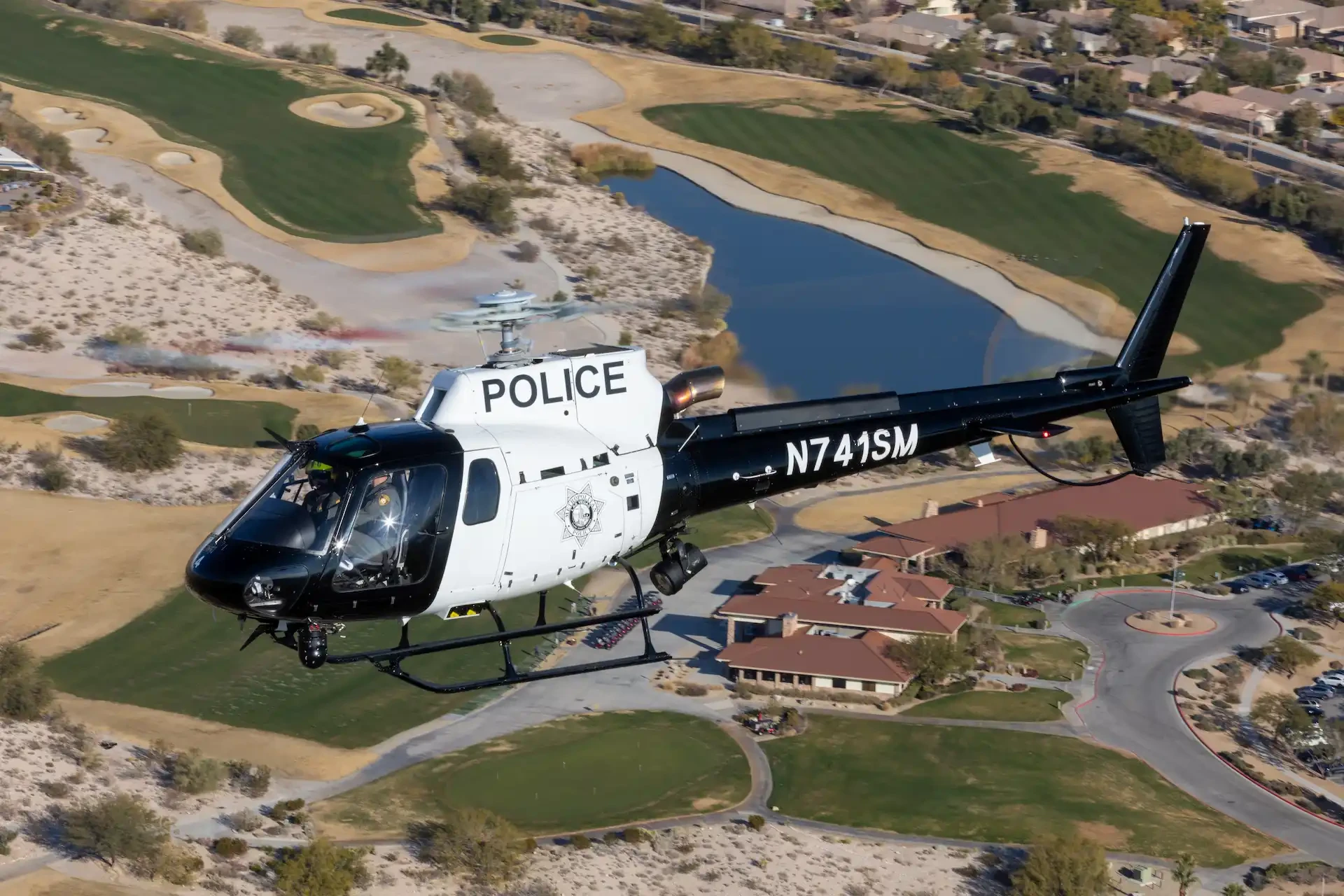After around five decades of operating the venerable MD500 series airframes, Las Vegas Metro PD has introduced the Airbus H125 into its
aerial law enforcement operation, as senior Air Support Unit personnel discussed with Ned Dawson.
Alternates
Approximately three years ago and shortly after commissioned Director Steve Morris took over as commander of Las Vegas Metro PD Air and Rescue Operations, the 29-year policing veteran began looking at alternate airframes for the MD530s operated by the unit. “I wanted more options for our patrol helicopters. Basically, there were three things that we saw as shortfalls of the MD530F that were the most important factors in the decision to upgrade the fleet,” he recounted. “Endurance was one factor; we knew it wasn’t hoist-capable and it wasn’t climate controlled. It gets very hot here; up to 115 degrees or more in the summer months and I didn’t think it was a good idea to continue flying doors-off for eight or nine months a year,” he stated.
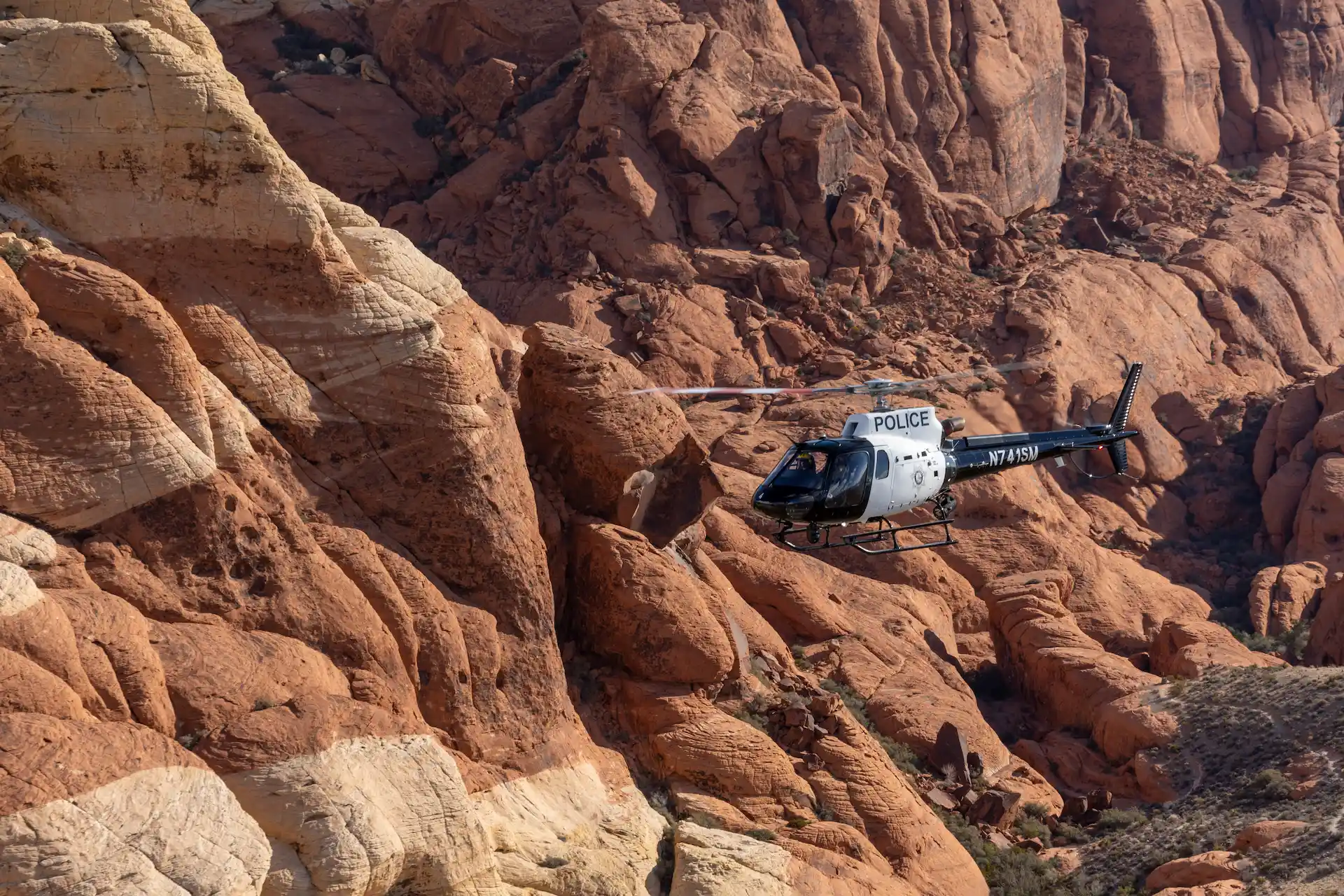
Morris went on to explain that flying with the doors off requires operating the 530 in a nearly constant out-of-trim configuration, with slight right pedal to protect the TFO (tactical flight officer) from excessive wind and noise. In addition to the operational constraints and increased mechanical wear, he acknowledged the detrimental health aspect of excessive noise on a pilot’s hearing over years of a flying career. “We have an annual physical and we can track the damage to our hearing from year to year. The aircraft equipment is also more exposed with the doors off, and we believe that operating in an enclosed cockpit is a far preferable scenario.”
The maximum operational endurance of our 530’s is about an hour and fifty minutes, after which they must land and either hot-fuel or shut down. “That is really not great for pursuits or high-priority calls that are not static, as we might get an urgent call more than an hour into our patrol and then only have half an hour before having to leave the scene, hot-fuel and come back,” noted Morris. The ability to equip the patrol aircraft with a hoist was seen as highly desirable as a single Airbus H145 rescue helicopter replaced the prior complement of two HH-1 Hueys, and it is out of service at least once a year for its annual inspection. “That takes it out for four to six weeks and now we don’t have a backup hoist-capable helicopter. It was under my watch that we replaced the two Hueys with the H145, so I recognized that it was really important to have that additional hoist capability,” he remarked.
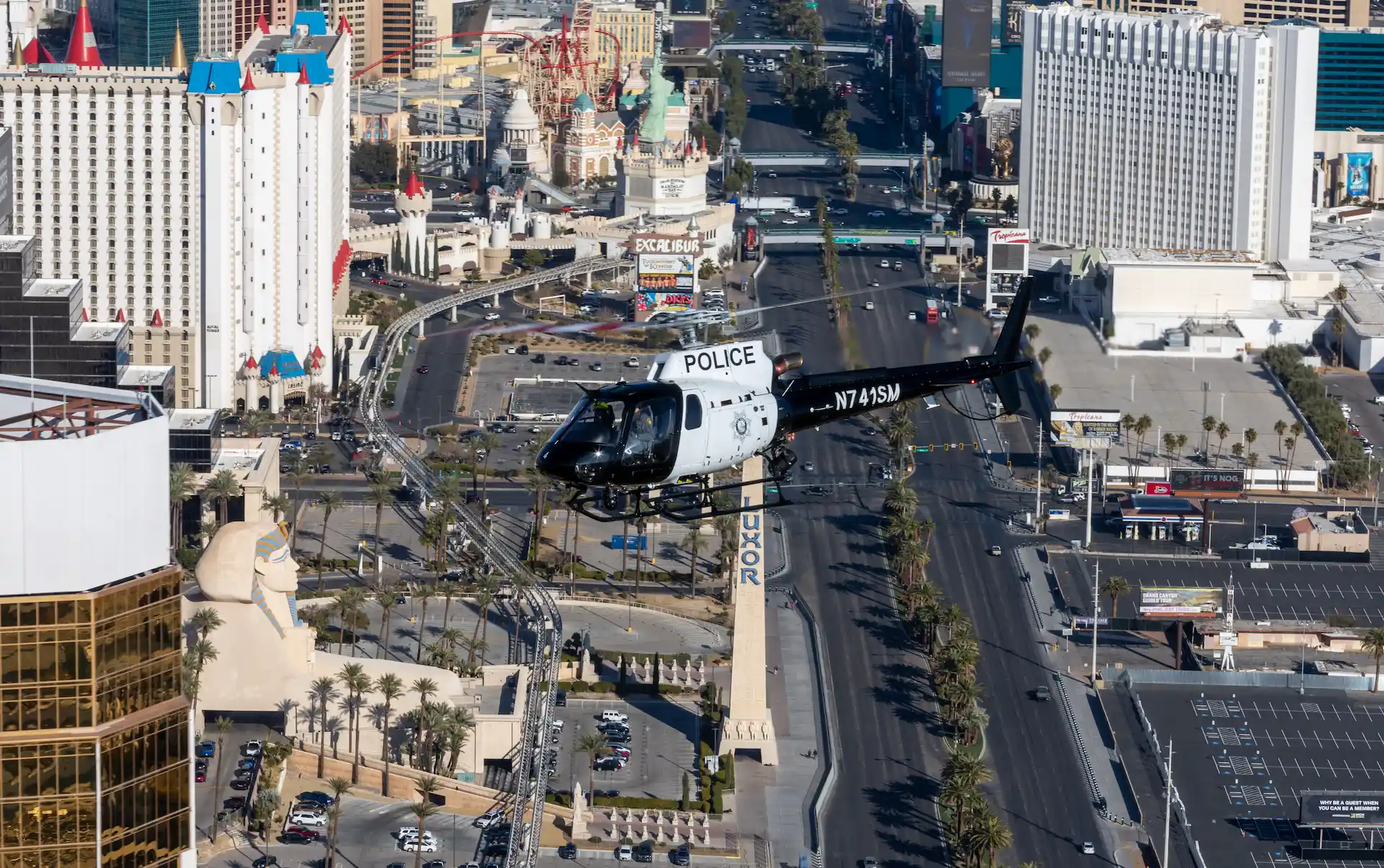
Settling on the H125
Choosing a new airframe meant looking at a number of possible types and Morris said that AgustaWestland’s AW109 and AW119, various Airbus types, Bell and the MD902 were all considered. Although several light twins were among those initial considerations, MD Helicopters were unable to supply a MD902 for demonstration at the time and Morris explained that in any case, financial considerations made a twin-engine type problematic due to the high patrol utilization of the fleet, commenting, “We typically fly our patrol helicopters ten to fifteen hours a day. We’re not on standby, we’re either up flying active patrol or on patrol support.” The assorted offerings were researched, and several other agencies were contacted, visited, and questioned about their operational experience with the various types under consideration. “After that we decided that we wanted to look closer at the H125. Airbus sent out a demo’ machine more than once, we also went to Texas and flew one of theirs’ and it finally worked out that we decided the H125 was the best fit for us. Airbus was very professional and good to deal with, and they even leased Riverside County Sheriff’s helicopter and an instructor pilot, brought it to Las Vegas and for a week - Mike Calhoun and his crew flew with the four of us who were most likely to be the initial pilots on the new aircraft. That aircraft had the hoist on it and we got to fly it in our own environment here.” Morris noted that it was also a consideration but not a necessity that many law enforcement aviation units already utilize the 125.
Airbus carried out the completion on the new machine – as it did for the H145 rescue aircraft, and Morris explained that a factory completion offered significant advantages. “As a government agency we have to be very conscious of financial responsibility. Also, having a single provider for aircraft manufacture and completion simplifies things for the finance team, our legal team and for the Air Support Unit, particularly if there are problems when you only have to deal with one company,” he noted. The new H125 has been fitted out as a patrol helicopter with multi-mission capability and has provision for a hoist to be fitted, although the hoist has not yet been obtained. “We plan on getting the Goodrich hoist for it in the next or following fiscal year as we don’t just want, but need a hoist capable helicopter here in Las Vegas, because we rescue so many people in our mountains. The way our schedule works, the 145 usually goes out for its annual in the spring, and that’s a really busy time for us with Red Rock Canyon, Mount Charleston, the Valley of Fire, Apex Dunes, Lake Mead, all these fantastic recreational areas.”
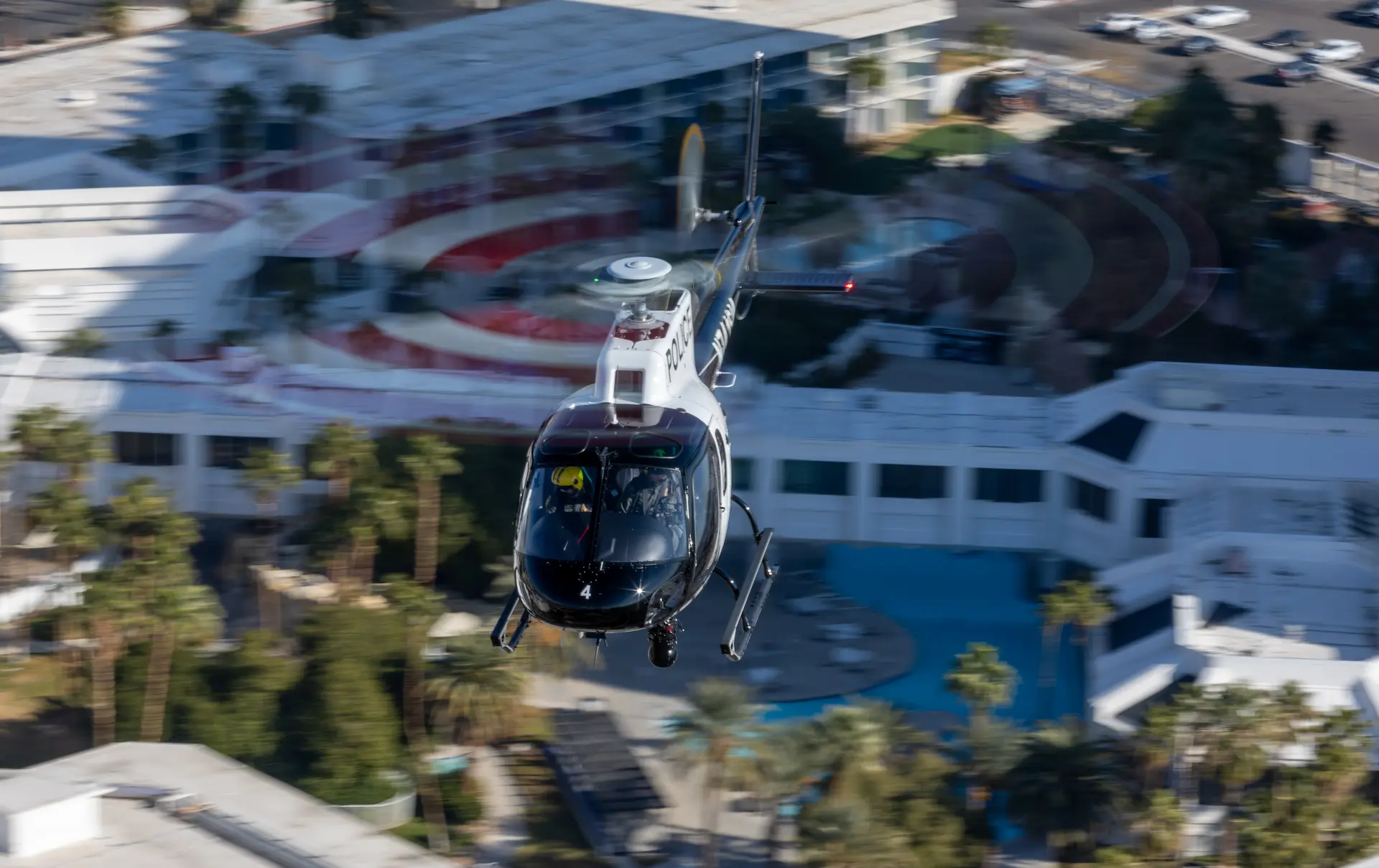
Cockpit Flexibility
One benefit of the H125 is that its cockpit configuration allows the use of a larger Macro-Blue monitor (17in) for the TFO than either the 530F or the H145, but mission equipment is highly standardized across the entire LVMPD helicopter fleet and includes Technisonic TDFM radios, Garmin GPS system, Spectrolab Nightsun searchlight, Wescam MX-10 imaging system and Macro-Blue monitors. “For ease of operation and efficiency we want everything to be ‘in sync’, so you don’t get out of one helicopter with certain equipment and into another with something different,” said Morris. Similar reasoning means that Airbus sent its instructors to Las Vegas for initial type training for the unit’s instructor cadre, so that it was carried out in the unit’s own area, on its own aircraft.
An additional, more mission-oriented training package is also provided by Airbus and Morris is complimentary about the manufacturer’s flexibility in regard to its training offerings, adding, “Even though it’s not as costly, I’m not a fan of internal initial transition. I think the safest thing when moving into a new aircraft type is to go with factory training. Whether it’s Airbus, Leonardo, MD or Bell, let the manufacturer tell you what the best practices are for their product.” Morris explained that after the initial three-hour factory transition, the plan is to provide fifteen hours of additional type familiarization before a pilot is dispatched on any active operational flying. He and the three instructors are themselves approaching that fifteen-hour mark and once there, will then assess whether it is considered sufficient or whether more familiarization time is desirable. The familiarization period focuses primarily on near-ground operations. “We take it around to the areas we most commonly land at. We go to our BLM fire station, our communications center, the Red Rock Canyon overlook and all the area’s regional and local airports we would fly to in Utah, Nevada, Arizona and California.”
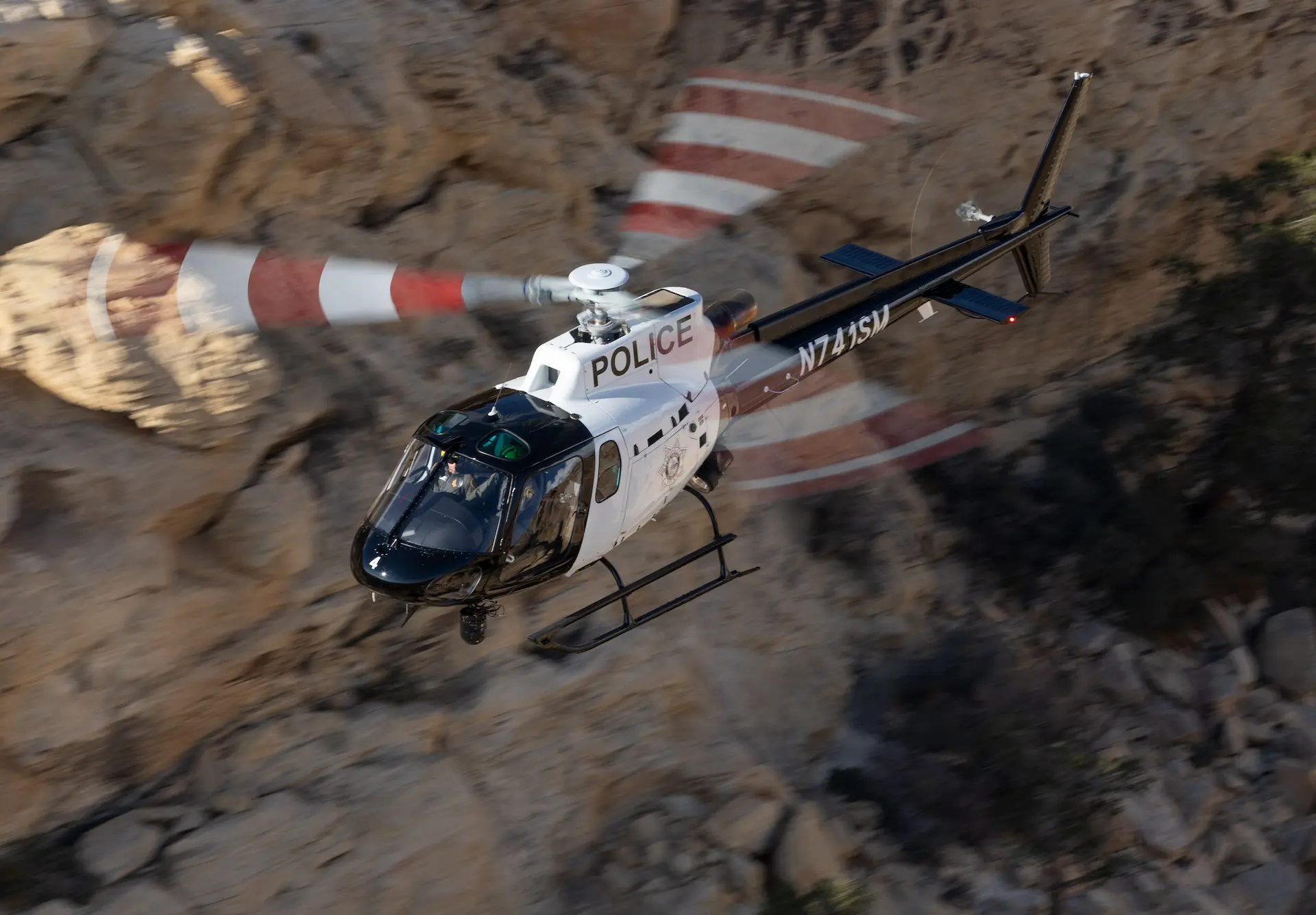
Design Review – Lessons Learned
Problems and issues arising from deliveries of new helicopters in years past led the Air Support Unit to institute what it calls a ‘design review committee’ during the build process of its new helicopters, commencing with its H145. “I’ll take someone from finance, someone from maintenance, someone from SAR if it’s a rescue helicopter, my chief pilot and my special flights pilot, to make sure nothing is missed as the aircraft progresses through the build.” Morris advised that the design review process dramatically reduced problems on delivery. “Before we started design reviews switches would be in the wrong place, or things weren’t ergonomically correct for how our crews operate. Now, there are almost no hiccups and the only thing we had to deal with on the H125 was that Airbus had provided no storage for the pilot or TFO, even for such little things as a phone or notepad – but that is being rectified.”
A Little Different
Transitioning to a new type always presents some challenges and Morris described the H125 as definitely more difficult to pick up, hover and land than the MD530, which remains in service with the unit. “The 530 is easier to pick up and set down as the 125 is more ‘squirrelly’, but the 125 is a better performer in every other regard. However, I have nothing bad to say about the 530. We love our 530Fs and there is no guarantee that the H125 will be a total fleet replacement going forward. That is the intention at this stage, but it will probably take at least a year to truly evaluate the new helicopter against what it is intended to replace, and if everybody doesn’t see the benefit once they’re all flying it, we could certainly stay in some 530s.” The H125 pilot-in-command seat is on the aircraft’s right side, whereas the 530F is ‘left-hand drive’ so the new type dictates a change from a right-hand orbit to a left-hand orbit to keep the TFO on the inboard side of the turn. The large size of the H125 is a factor for transitioning pilots to adapt to and the type’s less forgiving flight characteristics near the ground mean that, unlike the 530s, it is not currently being landed adjacent to the on-site fuel tanks. “That’s not a problem for us because we have a fuel truck, and we can just land on our two pads further away, or the taxiway.”

The H125 completely eliminates the endurance issues of the 530F, with Morris quipping that the H125 pilot will run out of bladder before the aircraft runs out of fuel. “At our flight profile, which is 60kts and 500ft AGL, we’ve seen over four hours of endurance, but we’ll probably be looking at a standard sortie duration of two and a half hours,” he advised. This factor alone will facilitate a notable increase in efficiency as the 530s are already typically flown for two and a half hours, but that patrol time makes a fuel stop necessary, something the H125 will not require. Crew comfort is enhanced in the H125, which boasts a larger cockpit and seats that permit greater fore-and-aft seat movement.
Tom Cognian is one of the unit’s flight instructors, with around 2,800hrs rotary-wing time and five years on the air support unit. His participation in the design review process and input into the new aircraft’s cockpit layout gave him an intimate familiarity with the Las Vegas Metro H125 right from the get-go. “I was quite excited when I heard we were getting one, because everyone you speak to in the industry has only good things to say about the H125,” he recalled. “It was very different in the beginning, coming from the 530. When you’re about ten hours in though, your brain makes that switch. It’s the first opposite rotation helicopter I’ve flown so for me it is different, but when you’re in forward flight it just flies like any helicopter. The differences are really only noticeable when you’re slowing down and coming into land. This helicopter has a ton of power and a lot of tail-rotor authority. In my opinion it allows a pilot to be a little more sloppy because you’re never near the limits, you can just pull more power and you’re gone. It’s when you start operating near the limits that you have to be good, because if you’re not it can bite you in the ass and you’re going to crash.”
Cognian agreed with Morris in the vital importance of rolling out the introduction of a new type safely, not only for the wellbeing of crew and public, but also because a crash in the first year of operation would most probably result in the administration’s rejection of the new type and a return to the proven but less than optimal MD530Fs. “We’re not in the business of worrying about making a profit, so it’s not about doing this quickly, it’s all about rolling it out safely.” Once Morris and the three CFIs complete their familiarization, the H125 will be put through its paces on daytime patrol to establish best operational procedures, with that process then repeated for nighttime operations before other unit pilots are familiarized on type.
New Life for Old Horse
Although Morris will be retired by the time this article is published, he pointed out that unit flight training is carried out in-house and remarked that if he was remaining as the director and saw through fleet replacement onto the H125, he would probably choose to keep one of the unit’s MD530Fs as a training aircraft, commenting, “There’s probably not a better helicopter to train on than a 530F. It’s a very good two-person helicopter that does high, hot and heavy very well, so I see it as an ideal primary trainer before transitioning to the H125. The 530 is very safe. It has a fairly high tail-rotor and its ‘eggshell’ cabin is very safe in a crash. Our safety procedures and protocols usually exceed what the FAA requires and we’re always looking at what other operators are doing. We also like to have other operators look at what we do.” Morris boasts thirteen years on the Air Support Unit and during his four years as director the unit has not had an accident or even a reportable incident, the longest such continuous period in the unit’s 53-year history, so it is clear that the commitment to safety is firmly embedded in the unit’s culture and Morris’ mantra.
Despite the unit’s long history with the 500-series of aircraft, Cognian remarked that he is hard-pressed to find anyone who doesn’t prefer the H125 over the MD530. “There are just so many things that check the boxes for us. The air conditioning, the range, the power and the extra space you have. We took off with three people in the back and full fuel, and you couldn’t even notice it,” he enthused. Providing all goes well during the final few hours of familiarization, Director Morris expects the H125 to be introduced to active patrol duty within the next week or two. “We’re still evaluating it but we’re loving it so far. We thought the 530 was powerful but it’s got nothing on this, the performance of the H125 is amazing. The 530F has been a great helicopter for Las Vegas Metro and we’ve caught a lot of bad guys with it. If we had to stick with it, it would still do a great job but everything is going well so far with the H125 and I’m confident that we picked the right helicopter for our fleet replacement.”
 HOME
HOME


